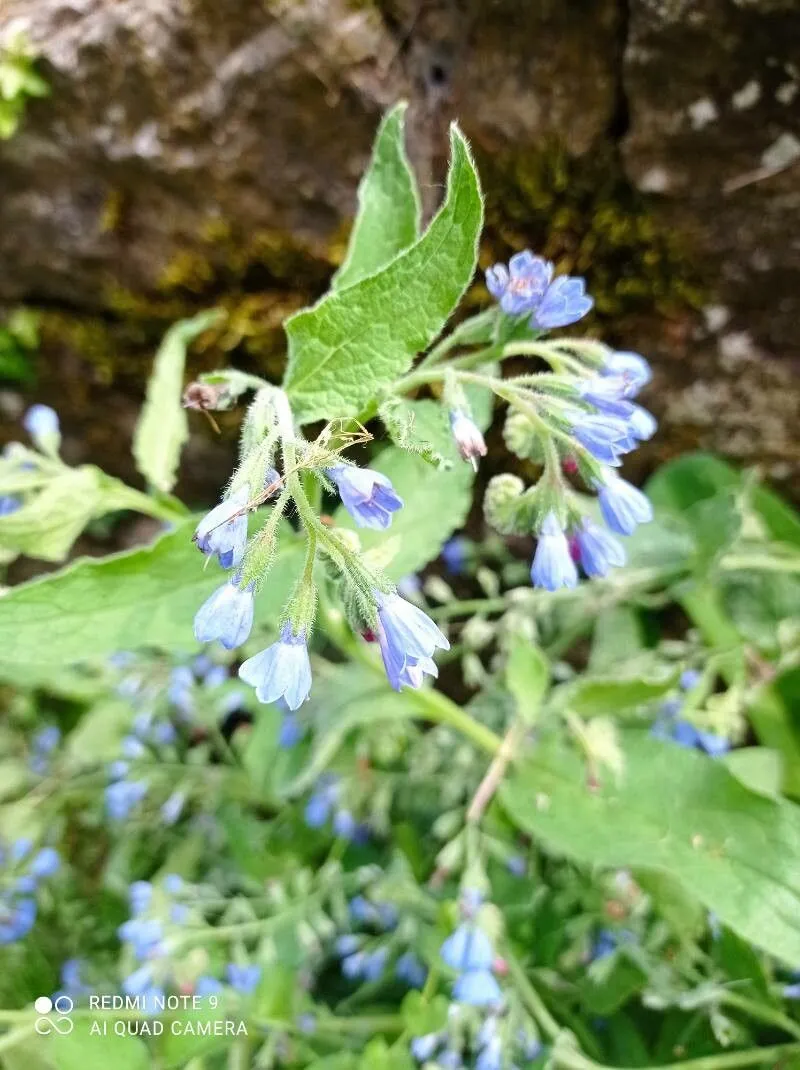
Author: M.Bieb.
Bibliography: Fl. Taur.-Caucas. 1: 128 (1808)
Year: 1808
Status: accepted
Rank: species
Genus: Symphytum
Vegetable: False
Observations: E. Europe to Caucasus
Caucasian comfrey, scientifically known as Symphytum caucasicum, is a notable species within the Boraginaceae family. Described by M. Bieb. in 1808 in “Flora Taurico-Caucasica,” this perennial herb has carved out its niche in the botanical landscapes of Eastern Europe and the Caucasus region.
Characterized by its robust stature, Caucasian comfrey is a plant of great ecological importance and horticultural interest. It typically thrives in temperate climates, favoring moist and fertile soils, which are abundant in its native habitat. The plant features broad, lance-shaped leaves that are covered in fine, bristly hairs, contributing to its somewhat coarse texture.
In early summer, Symphytum caucasicum showcases clusters of tubular, bell-shaped flowers that range in color from deep blue to violet. These vibrant blooms not only add an element of beauty to its natural surroundings but also play a significant role in attracting pollinators such as bees, bolstering local biodiversity.
Due to its vigorous nature and the dense foliage it forms, Caucasian comfrey is often employed in permaculture and sustainable gardening practices. It is particularly valued for its ability to improve soil structure and fertility. The deep roots of the plant help to draw up nutrients from the subsoil, making it an excellent companion plant for various crops. Additionally, the leaves can be cut and used as a green mulch or compost activator, enriching the soil with essential nutrients.
Caucasian comfrey’s historical and geographical significance ties closely with its distribution across Eastern Europe and the Caucasus. These regions have long recognized the plant not only for its ecological benefits but also for its medicinal properties. Traditionally, comfrey extracts have been used in folk medicine for their purported wound-healing and anti-inflammatory effects, although such uses should be approached with caution due to potential toxicity.
Overall, Symphytum caucasicum stands as a testament to the intertwined relationships between flora and their environments, reflecting the intricate beauty and utility found within nature. Its enduring presence across diverse landscapes underscores the adaptability and resilience characteristic of the Boraginaceae family.
Eng: caucasian comfrey, blue comfrey
Deu: kaukasischer beinwell
Dan: kaukasisk kulsukker
Swe: bergvallört
Fra: consoude de caucase
Nld: kaukasische smeerwortel
Cym: cyfardwf y caucasus, cyfardwf y cawcasws
En: Caucasian comfrey, Blue comfrey
Da: Kaukasisk kulsukker
Nl: Kaukasische smeerwortel
Fr: Consoude de Caucase
De: Kaukasischer Beinwell
Sv: Bergvallört
Cy: Cyfardwf y Caucasus, Cyfardwf y Cawcasws
Taken Jun 7, 2022 by Света (cc-by-sa)
Taken Jun 14, 2022 by Michaelo Sforza (cc-by-sa)
Taken May 22, 2022 by claudine cuby (cc-by-sa)
Taken May 23, 2021 by ksou ksou (cc-by-sa)
Taken May 20, 2022 by Bernard Levoisin (cc-by-sa)
Taken Jun 25, 2021 by Laure Duron (cc-by-sa)
Taken Apr 26, 2017 by Tela Botanica − Gérard LEVESLIN (cc-by-sa)
Taken Jul 30, 2021 by Yves Guédon (cc-by-sa)
Taken Dec 1, 2021 by William Arthur (cc-by-sa)
Taken Jun 16, 2022 by Ertan Seçkin (cc-by-sa)
© copyright of the Board of Trustees of the Royal Botanic Gardens, Kew.
© copyright of the Board of Trustees of the Royal Botanic Gardens, Kew.
© copyright of the Board of Trustees of the Royal Botanic Gardens, Kew.
Family: Myrtaceae Author: (F.Muell.) K.D.Hill & L.A.S.Johnson Bibliography: Telopea 6: 402 (1995) Year: 1995 Status:…
Family: Rubiaceae Author: Pierre ex A.Froehner Bibliography: Notizbl. Bot. Gart. Berlin-Dahlem 1: 237 (1897) Year:…
Family: Sapindaceae Author: Koidz. Bibliography: J. Coll. Sci. Imp. Univ. Tokyo 32(1): 38 (1911) Year:…
Family: Asteraceae Author: A.Gray Bibliography: Pacif. Railr. Rep.: 107 (1857) Year: 1857 Status: accepted Rank:…
Family: Fabaceae Author: Medik. Bibliography: Vorles. Churpfälz. Phys.-Ökon. Ges. 2: 398 (1787) Year: 1787 Status:…
Family: Aspleniaceae Author: (Cav.) Alston Bibliography: Bull. Misc. Inform. Kew 1932: 309 (1932) Year: 1932…